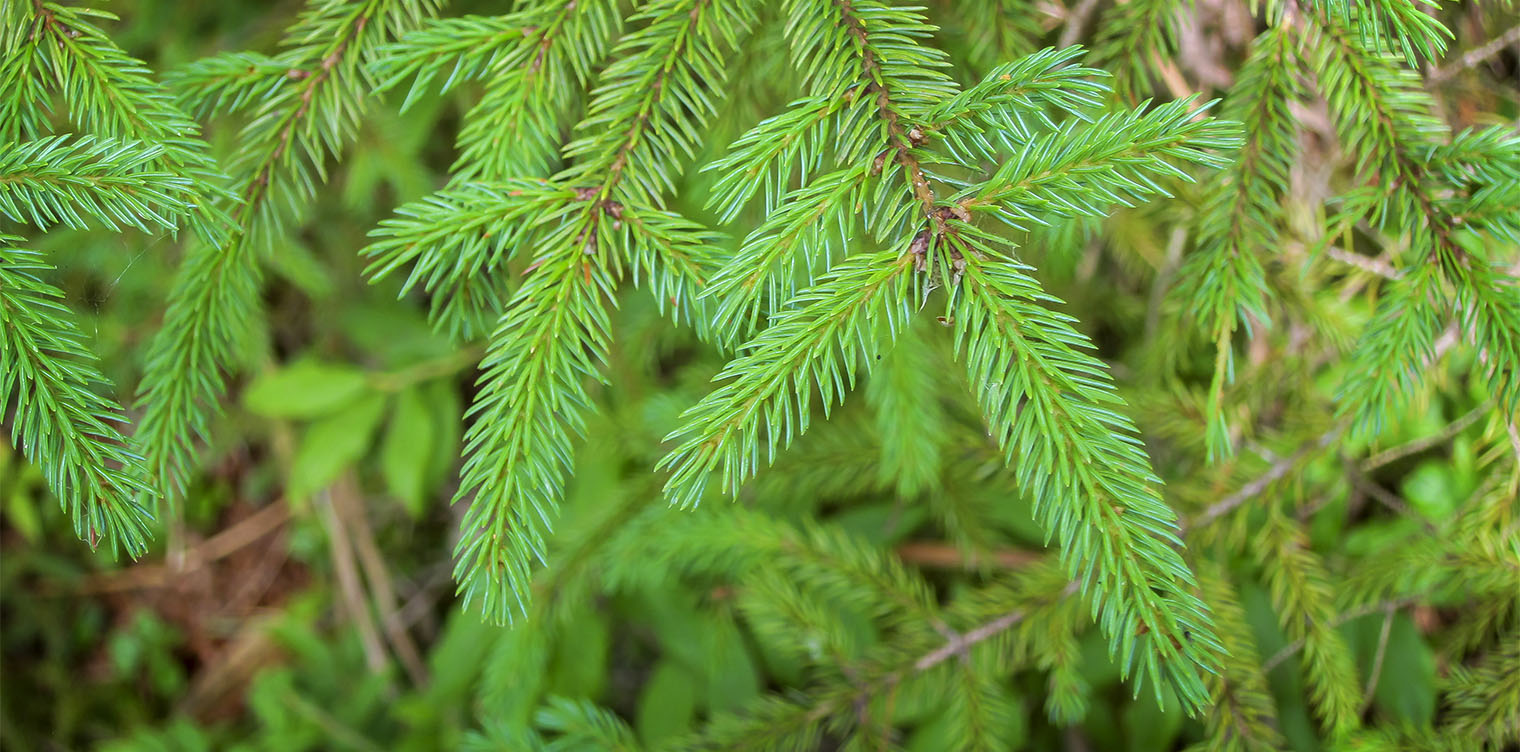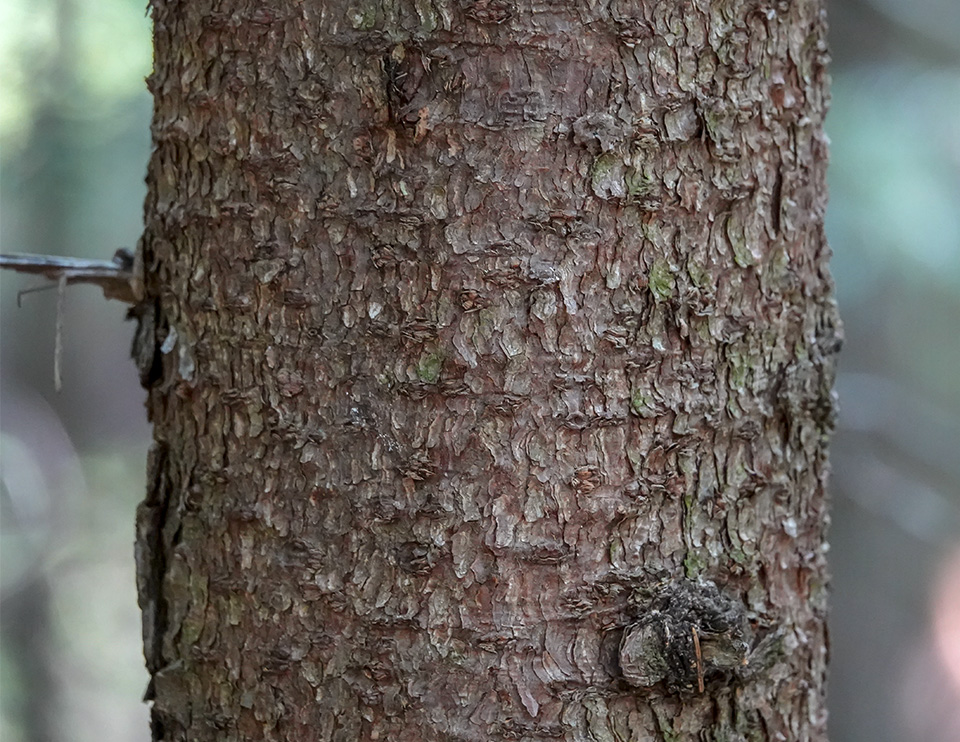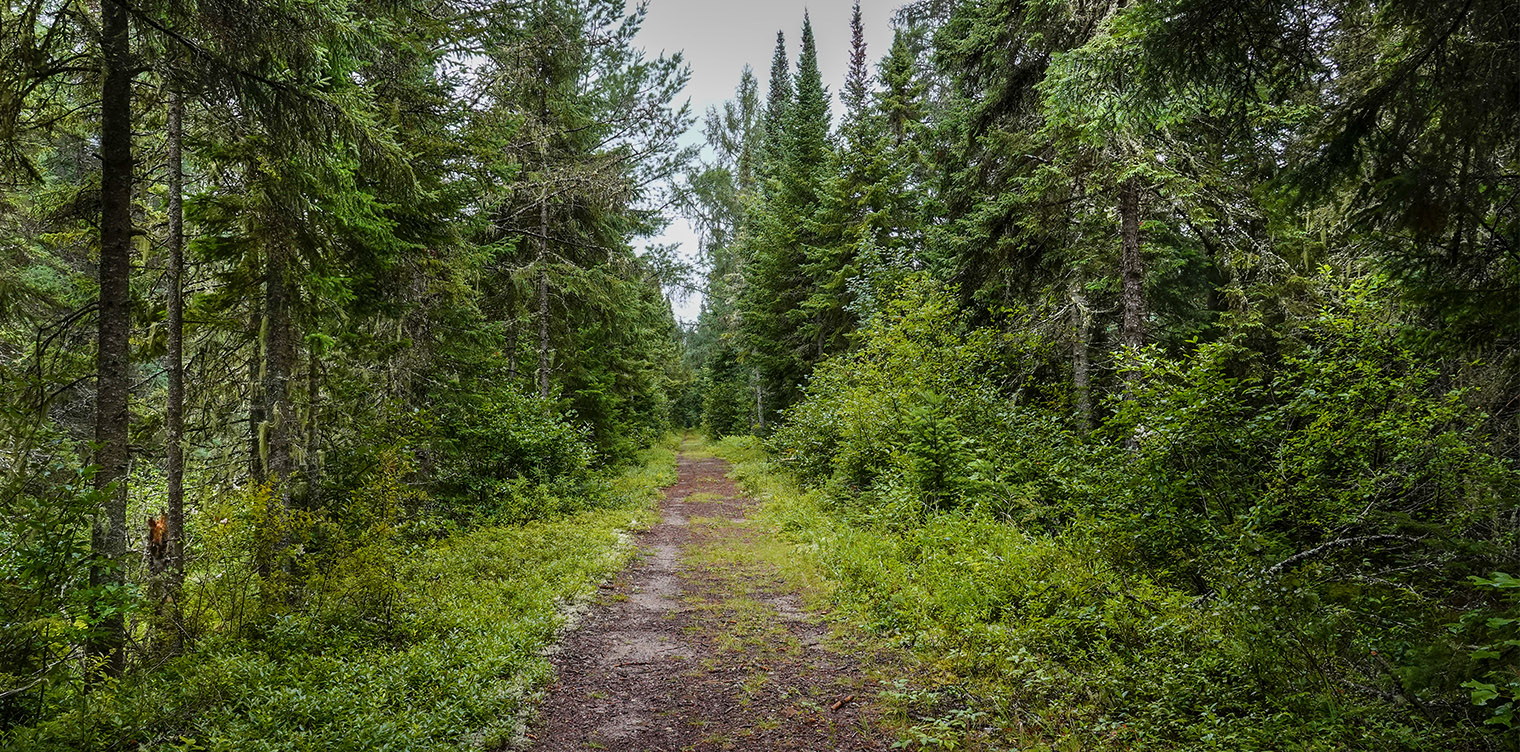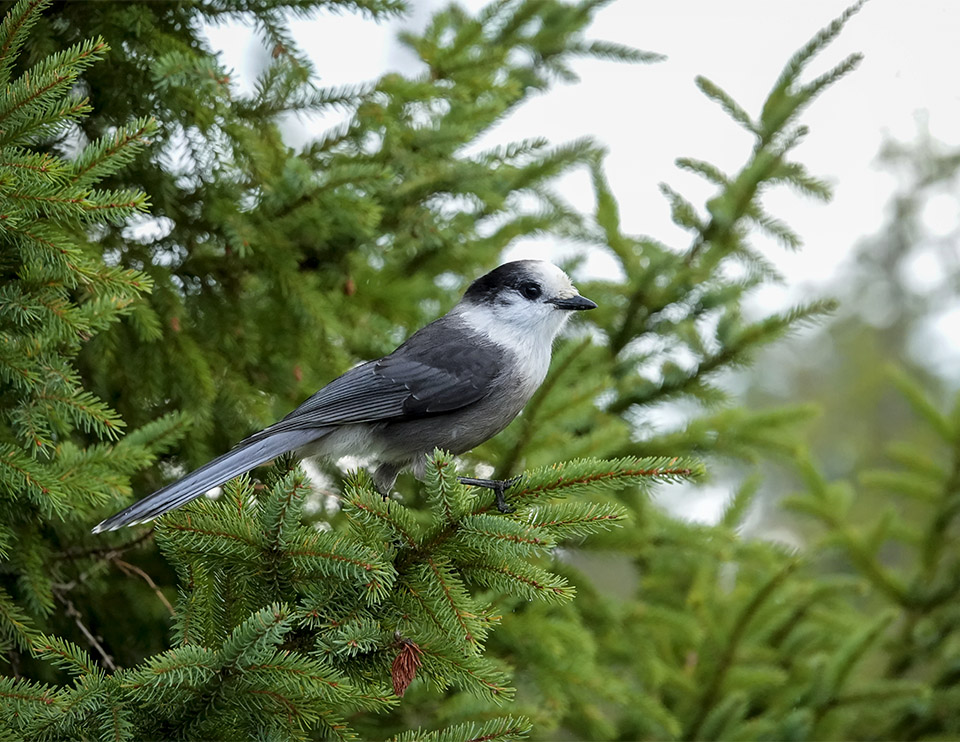Trees of the Adirondacks:
Red Spruce (Picea rubens)

The Red Spruce (Picea rubens) is a medium-sized evergreen conifer that grows in cool, boreal forests of the northeast, including the Adirondack Mountains. This species is the conifer species most typical of the Adirondack region as a whole. Early records suggest that the Red Spruce constituted a quarter of the forest cover in the northern Adirondacks at one time.
This species is a member of the pine family. This tree is also known as Yellow Spruce, West Virginia Spruce, Eastern Spruce, and He Balsam. The latter name is to distinguish the Red Spruce from the southern-growing Fraser Fir, which is known as "She Balsam". Red Spruce is the provincial tree of Nova Scotia.
Identification of the Red Spruce

Red Spruce trees have four-sided, short, yellowish green needles on woody pegs. The cones, which fall soon after maturity, are around 1½ inches long. They hang pendantly and are reddish-brown and woody. The slender new twigs have a reddish coat of down through the first year. The bark of Red Spruce trees is gray-brown to reddish brown.
This species flowers in May. The pendant male flowers are bright red, while the female flowers are erect and bright green tinged with purple. In growth habit, this tree is rather open-branched, with up-curved tips.
Keys to identifying the Red Spruce and differentiating it from other coniferous trees include its needles, bark, growth habit, and habitat.
- Red Spruce trees are easily distinguished from Eastern White Pine, since the latter tree has much longer needles in bundles, while the needles of the Red Spruce grow individually on the twig.
- Red Spruce needles can also be differentiated from those of the Balsam Fir, which are also short. Balsam Fir needles, particularly those on lower branches, appear to be two-ranked. The needles appear to occupy a single horizontal plane and are soft and friendly to the touch. Red Spruce needles, by contrast, are sharp-pointed and prickly, growing all around the twig. Moreover, Red Spruce needles are four sided, in contrast to the flat needles of the Balsam Fir. Finally, the cones of Red Spruce are orange-brown, contrasting with the bluish brown cones of the Balsam Fir. The bark is another key identifier, since Red Spruce bark lacks the resin blisters of the Balsam Fir.
- The needle arrangement of Red Spruce also differentiates it from that of Eastern Hemlock, which appear to occupy a single horizontal plane.
- The arrangement of Red Spruce needles also contrasts with that of Tamaracks. Tamarack needles are relatively short, like those of the Red Spruce, but are produced in clusters of ten to twenty, as opposed to the single needles of the Red Spruce. Moreover, Tamaracks thrive in much wetter soil than Red Spruce.
- Red Spruce can be distinguished from Black Spruce by its growth habit and habitat. The silhouette of a Red Spruce tree is pyramidal. By contrast, Black Spruce trees are slender, with short branches. Moreover, Black Spruce trees thrive in the middle of bogs, where Red Spruce does not grow.
Differentiating Red Spruce from White Spruce is somewhat trickier.
- The needles of Red Spruce are yellowish green, in contrast to the bluish green needles of the White Spruce. Moreover, the needles of the Red Spruce exude a fruity scent similar to that of orange rind when crushed. By contrast, the needles of the White Spruce (sometimes known as the Cat Spruce or Skunk Spruce) exude a pungent odor evocative of cat urine or skunk when crushed.
- The cones of the Red Spruce are somewhat smaller than those of White Spruce.
- Red Spruce tends to be more open-branched than White Spruce.
Uses of the Red Spruce
Red Spruce is one of the most important forest trees in the northeast. The wood is light, soft, and faintly tinged with red. This tree is used primarily for lumber and pulpwood. It is also used for construction lumber, plywood, boxes, sash frames, and musical stringed instruments. It is the preferred wood for piano sounding boards, guitars, mandolins, organ pipes, and violin bellies. It is also used as a Christmas tree. One unique use of red spruce was spruce gum.
This plant is not widely used medicinally. However, several North American Indian tribes employed it as a remedy for throat ailments, lung trouble, and measles; the needles were also used to make a beverage and the gum to make pitch. Native people also used the peeled roots of Red Spruce for lacing. Early settlers used the fresh green buds to flavor beers.
Wildlife Value of the Red Spruce
Red Spruce provides food and cover for various mammals and birds. Habitats which include Red Spruce are particularly important as winter cover for White-tailed Deer and, to a certain extent, Moose. Red Squirrels eat buds and seeds. Mice and voles consume and store significant amounts of spruce seeds. North American Porcupines feed on the bark in winter.
Red Spruce provides food and nest sites for a number of birds. The Spruce Grouse feeds on the buds and foliage. Red spruce seeds reportedly make up 25 to 50 percent of the diet of White-winged Crossbills. Black-throated Green Warblers and Pileated Woodpeckers also forage on Red Spruce trees.
The Red Spruce is a common tree species in the breeding habitat of a wide variety of birds, including:
Blackpoll Warbler
Black-throated Green Warbler
Canada Warbler
Cape May Warbler
Evening Grosbeak
Golden-crowned Kinglet
Magnolia Warbler
Mourning Warbler
Northern Saw-whet Owl
Olive-sided Flycatcher
Red-breasted Nuthatch
Spruce Grouse
White-throated Sparrow
Yellow-bellied Flycatcher
Yellow-rumped Warbler
Distribution of the Red Spruce
The range of this species is more limited than those of the Black Spruce, Tamarack, or Balsam Fir. The range of the Red Spruce extends only from the Maritime Provinces of Canada west to Maine, southern Quebec, and southeastern Ontario, and south into central New York, eastern Pennsylvania, northern New Jersey, and Massachusetts. There are also stands of Red Spruce in parts of the Appalachian Mountains.
In New York State, Red Spruce trees are found primarily in the northern and eastern parts of the state, including the Adirondack Mountains and the Catskills. Within the Adirondack Park, Red Spruce trees are found in all counties within the Blue Line.
Habitat of the Red Spruce

Red Spruce trees grow in climates with cool, moist summers and cold winters. Most of the soils on which Red Spruce occurs are developed from glacial deposits. This species is very high on the scale of shade tolerance. It will grow slowly in the shady understory for many decades, poised to take advantage of any opening in the canopy, then grow rapidly to a canopy position. It is generally considered a climax species.
Red Spruce is categorized as a Facultative Upland (FACU) plant, meaning that it usually occurs in non-wetlands, but may occur in wetlands. Red Spruce can grow in a variety of soils. It prefers well-drained soils, but can also grow in moister soils. It is found in both conifer and mixed woods forests, as well as in some wetland habitats. It does not grow in the middle of bogs, but can be found on swampy ground.
In the Adirondack region, Red Spruce can be found in a wide variety of ecological communities:
In the Adirondacks, you can find Red Spruce scattered among northern hardwoods below 2500 feet in elevation, but it is most common on sites where Sugar Maple and American Beech cannot grow well, where the soils are either too sandy or too wet or near rock outcrops.

For example, Red Spruce can be seen in spruce flats, a conifer or mixed forest often found on moist sites along the borders of swamps, as well as along lakes and streams. This community is transitional between wetland and upland. The soil is loamy to sandy; it is usually saturated in the early spring right after the snow melts, but moderately well-drained for much of the growing season.
- The dominant trees in this ecological community are Red Spruce, as well as smaller numbers of Eastern Hemlock, Yellow Birch, and Black Cherry. Other hardwoods, such as American Beech, may be present in small numbers.
- Characteristic shrubs include Sheep Laurel and blueberries. The shrub layer in spruce flats sites is generally sparse and patchy.
- The forest floor is usually covered by mosses, including Schreber's Big Red Stem Moss, Stair-step Moss, and leafy liverwort.
- Characteristic wildflowers include Creeping Snowberry, Goldthread, Dewdrop, Bunchberry, and Canada Mayflower.
- Characteristic birds include Golden-crowned Kinglet, Ruby-crowned Kinglet, Swainson's Thrush, White-throated Sparrow, Wilson's Warbler, Yellow-bellied Flycatcher, Black-backed Woodpecker, Lincoln's Sparrow, Blackburnian Warbler, Palm Warbler, Magnolia Warbler, and Canada Jay.
Outlook for the Red Spruce in the Adirondack Park
This species is vulnerable to damage from acid rain. Although acid rain – the result of pollutants in the emissions from power plants and other industrial facilities – has stressed Adirondack forests as a whole, two species have experienced particularly heavy losses: Red Spruce and Sugar Maple.
In regard to the Red Spruce, acid rain leaches calcium out of the needles and reduces the needles' ability to tolerate freezing temperatures. Acid rain also interferes with the tree's ability to acquire nutrients from the thin Adirondack soils. This combination of reduced freeze tolerance and nutrient stress, which makes the trees more susceptible to insects and disease, is thought to be responsible for the loss of roughly half of the high-altitude spruce forests in the Adirondacks.
Adirondack Tree List
References
Michael Kudish. Adirondack Upland Flora: An Ecological Perspective (Saranac, New York: The Chauncy Press, 1992), pp. 42, 96-97.
E. H. Ketchledge. Forests and Trees of the Adirondack High Peaks Region (Adirondack Mountain Club, 1996), pp. 73-77.
New York Flora Association. New York Flora Atlas. Red Spruce. Picea rubens Sarg. Retrieved 7 March 2017.
United States Department of Agriculture. The Plants Database. Red Spruce. Picea rubens Sarg. Retrieved 7 March 2017.
United States Department of Agriculture. Forest Service. Silvics of North America. Red Spruce. Retrieved 13 March 2015.
United States Department of Agriculture. Red Spruce Plant Guide. Retrieved 13 March 2015.
United States Department of Agriculture. Fire Effects Information System (FEIS). Species Reviews. Picea Rubens. Retrieved 7 March 2017.
Flora of North America. Retrieved 7 March 2017. Picea rubens. Sargent. Retrieved 7 March 2017.
New York State. Adirondack Park Agency. Preliminary List of Species Native Within the Adirondack Park Listed Alphabetically by Scientific Name and Sorted by Habit. Volume 1. Updated 10.23.2006, p.7. Retrieved 26 January 2017.
Northern Forest Atlas. Images. Red Spruce. Picea rubens. Retrieved 10 January 2021.
New York State. Department of Environmental Conservation. New York Natural Heritage Program. Ecological Communities of New York State. Second Edition (March 2014). Retrieved 17 October 2015.
New York Natural Heritage Program. 2022. Online Conservation Guide for Alpine Krummholz. Retrieved 29 March 2022.
New York Natural Heritage Program. 2022. Online Conservation Guide for Alpine Sliding Fen. Retrieved 29 March 2022.
New York Natural Heritage Program. 2022. Online Conservation Guide for Balsam Flats. RRetrieved 29 March 2022.
New York Natural Heritage Program. 2022. Online Conservation Guide for Beech-Maple Mesic Forest. Retrieved 29 March 2022.
New York Natural Heritage Program. 2022. Online Conservation Guide for Mountain Fir Forest. Retrieved 29 March 2022.
New York Natural Heritage Program. 2022. Online Conservation Guide for Mountain Spruce-Fir Forest. Retrieved 29 March 2022.
New York Natural Heritage Program. 2022. Online Conservation Guide for Pine-Northern Hardwood Forest. Retrieved 29 March 2022.
New York Natural Heritage Program. 2022. Online Conservation Guide for Spruce Flats. Retrieved 29 March 2022.
New York Natural Heritage Program. 2022. Online Conservation Guide for Spruce-Fir Rocky Summit. Retrieved 29 March 2022.
New York Natural Heritage Program. 2022. Online Conservation Guide for Spruce-Fir Swamp. Retrieved 29 March 2022.
New York Natural Heritage Program. 2022. Online Conservation Guide for Spruce-Northern Hardwood Forest. Retrieved 29 March 2022.
The Nature Conservancy. Acadian Sub-boreal Spruce Flat. Retrieved 29 March 2022.
The Nature Conservancy. Acadian Low Elevation Spruce-Fir-Hardwood Forest. Retrieved 29 March 2022.
The Nature Conservancy. Acadian-Appalachian Montane Spruce-Fir-Hardwood Forest. Retrieved 29 March 2022.
Cornell Lab of Ornithology, Ithaca, New York. Golden-crowned Kinglet, Ruby-crowned Kinglet, Swainson's Thrush, White-throated Sparrow, Wilson's Warbler, Yellow-bellied Flycatcher, Black-backed Woodpecker, Lincoln's Sparrow. Retrieved 31 January 2020.
Lady Bird Johnson Wildflower Center. Native Plant Database. Retrieved 13 March 2015.
Online Encyclopedia of Life. Picea rubens. Retrieved 13 March 2015.
University of Michigan. Native American Ethnobotany. A Database of Foods, Drugs, Dyes and Fibers of Native American Peoples, Derived from Plants. Picea rubens. Red Spruce. Retrieved 7 March 2017.
Plants for a Future. Database. Retrieved 13 March 2015.
New York State Department of Environmental Conservation. Winter Deer Foods. Retrieved 13 March 2015.
Jack Saul, "Spruce up Your ID Skills," Northern Woodlands, 24 December 2012. Retrieved 14 March 2015.
George A. Petrides. A Field Guide to Eastern Trees (Boston: Houghton Mifflin Company, 1998), pp. 38-39, 175.
George A. Petrides. A Field Guide to Trees and Shrubs (Boston: Houghton Mifflin Company, 1958,1972), pp. 3, 23-24, 40-41.
Gil Nelson, Christopher J. Earle, and Richard Spellenberg. Trees of Eastern North America (Princeton : Princeton University Press), pp. 60-61.
C. Frank Brockman. Trees of North America (New York: St. Martin's Press), pp. 38-39.
Keith Rushforth and Charles Hollis. Field Guide to the Trees of North America (Washington, D.C., National Geographic, 2006), p. 68.
National Audubon Society. Field Guide to North American Trees. Eastern Region. (New York: Alfred A. Knopf, 1980), Plates 25, 478, pp. 285.
John Kricher. A Field Guide to Eastern Forests. North America (Boston: Houghton Mifflin, 1998), pp. 62-67.
Alexander C. Martin, Herbert S. Zim, and Arnold L. Nelson. American Wildlife & Plants: A Guide to Wildlife Food Habits (New York: Dover Publications, 1951), pp. 237, 290.
Bruce Kershner, et al. National Wildlife Federation Field Guide to Trees of North America (New York: Sterling Publishing Co., 2008), pp. 100-101.
David Allen Sibley. The Sibley Guide to Trees (New York: Alfred A. Knopf, 2009), p. 47.
Douglass H. Morse, "Habitat Selection in North American Parulid Warblers," in Martin L. Cody (ed.), Habitat Selection in Birds (Orlando, Florida: Academic Press, Inc., 1985), pp. 131-157.
Douglass H. Morse, "Variables affecting the density and territory size of breeding spruce-woods warblers," Ecology (1976) 57: pp. 290-301.
James M. Ryan. Adirondack Wildlife: A Field Guide (Lebanon, New Hampshire, 2008), pp. 37-41.
Jon T. Scott, et al. "Decline of Red Spruce in the Adirondacks, New York," Bulletin of the Torrey Botanical Club. Vol. 111, No. 4 (October-December 1984), pp. 438-444.
Arthur H. Johnson, "Red Spruce Decline in the Northeastern U.S.: Hypotheses Regarding the Role of Acid Rain," Journal of the Air Pollution Control Association, November 1983, Volume 33, Number 11, 1049-1054.
